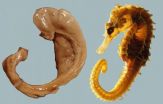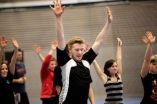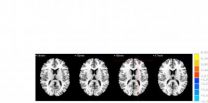(Press-News.org) COLLEGE PARK, Md. – A study of older adults at increased risk for Alzheimer's disease shows that moderate physical activity may protect brain health and stave off shrinkage of the hippocampus– the brain region responsible for memory and spatial orientation that is attacked first in Alzheimer's disease. Dr. J. Carson Smith, a kinesiology researcher in the University of Maryland School of Public Health who conducted the study, says that while all of us will lose some brain volume as we age, those with an increased genetic risk for Alzheimer's disease typically show greater hippocampal atrophy over time. The findings are published in the open-access journal Frontiers in Aging Neuroscience.
"The good news is that being physically active may offer protection from the neurodegeneration associated with genetic risk for Alzheimer's disease," Dr. Smith suggests. "We found that physical activity has the potential to preserve the volume of the hippocampus in those with increased risk for Alzheimer's disease, which means we can possibly delay cognitive decline and the onset of dementia symptoms in these individuals. Physical activity interventions may be especially potent and important for this group."
Dr. Smith and colleagues, including Dr. Stephen Rao from the Cleveland Clinic, tracked four groups of healthy older adults ages 65-89, who had normal cognitive abilities, over an 18-month period and measured the volume of their hippocampus (using structural magnetic resonance imaging, or MRI) at the beginning and end of that time period. The groups were classified both for low or high Alzheimer's risk (based on the absence or presence of the apolipoprotein E epsilon 4 allele) and for low or high physical activity levels.
Of all four groups studied, only those at high genetic risk for Alzheimer's who did not exercise experienced a decrease in hippocampal volume (3%) over the 18-month period. All other groups, including those at high risk for Alzheimer's but who were physically active, maintained the volume of their hippocampus.
"This is the first study to look at how physical activity may impact the loss of hippocampal volume in people at genetic risk for Alzheimer's disease," says Dr. Kirk Erickson, an associate professor of psychology at the University of Pittsburgh. "There are no other treatments shown to preserve hippocampal volume in those that may develop Alzheimer's disease. This study has tremendous implications for how we may intervene, prior to the development of any dementia symptoms, in older adults who are at increased genetic risk for Alzheimer's disease."
Individuals were classified as high risk for Alzheimer's if a DNA test identified the presence of a genetic marker – having one or both of the apolipoprotein E-epsilon 4 allele (APOE-e4 allele) on chromosome 19 – which increases the risk of developing the disease. Physical activity levels were measured using a standardized survey, with low activity being two or fewer days/week of low intensity activity, and high activity being three or more days/week of moderate to vigorous activity.
"We know that the majority of people who carry the APOE-e4 allele will show substantial cognitive decline with age and may develop Alzheimer's disease, but many will not. So, there is reason to believe that there are other genetic and lifestyle factors at work," Dr. Smith says. "Our study provides additional evidence that exercise plays a protective role against cognitive decline and suggests the need for future research to investigate how physical activity may interact with genetics and decrease Alzheimer's risk."
Dr. Smith has previously shown that a walking exercise intervention for patients with mild cognitive decline improved cognitive function by improving the efficiency of brain activity associated with memory. [see http://www.umdrightnow.umd.edu/news/exercise-may-be-best-medicine-alzheimers] He is planning to conduct a prescribed exercise intervention in a population of healthy older adults with genetic and other risk factors for Alzheimer's disease and to measure the impact on hippocampal volume and brain function.
INFORMATION:
"Physical activity reduces hippocampal atrophy in elders at genetic risk for Alzheimer's disease" was written by J. Carson Smith, Kristy A. Nielson, John L. Woodard, Michael Seidenberg, Sally Durgerian, Kathleen E. Hazlett, Christina M. Figueroa, Cassandra C. Kandah, Christina D. Kay, Monica A. Matthews and Stephen M. Rao and published in Frontiers in Aging Neuroscience.
Physical activity keeps hippocampus healthy in people at risk for Alzheimer's disease
Maintaining hippocampus volume is key to delaying cognitive decline and onset of dementia symptoms in those with genetic risk for Alzheimer's
2014-04-23
ELSE PRESS RELEASES FROM THIS DATE:
Chemical companies shore up supplement science
2014-04-23
As evidence mounts showing the potential health benefits of probiotics, antioxidants and other nutritional compounds, more and more people are taking supplements. And the chemical industry is getting in on the action. But legitimate skepticism about supplements' health effects could deter growth, so the industry is responding with clinical research to shore up health claims, according to the cover story in Chemical & Engineering News (C&EN), the weekly news magazine of the American Chemical Society.
Melody M. Bomgardner, a senior editor at C&EN, writes that about half ...
More Americans in their golden years are going hungry
2014-04-23
URBANA, Ill. - In a country as wealthy as the United States, it may come as a surprise that one in 12 seniors do not have access to adequate food due to lack of money or other financial resources. They are food insecure.
Recent research at the University of Illinois using data from the National Health and Nutrition Examination Survey (NHANES) revealed that the seniors who are dealing with hunger are also facing negative health and nutrition consequences.
"In 2011, 8.35 percent of Americans over age 60 faced the threat of hunger—that translates to 4.8 million people," ...
The surface area of the digestive tract 'only' as large as a studio apartment
2014-04-23
The internal surface area of the gastro-intestinal tract has long been considered to be between 180 and 300 square meters. Scientists at the Sahlgrenska Academy have used refined microscopic techniques that indicate a much smaller area.
"Actually, the inner surface of the gastro-intestinal tract is only as large as a normal studio apartment," says scientist Lars Fändriks.
The digestive tract, which passes from the mouth through the esophagus and onwards through the intestines, has a length of about 5 meters in a normal adult, and is built up with many folds and protrusions.
Previous ...
Change 'authoritarian' football culture to produce future stars, says research
2014-04-23
Premier League soccer stars are subjecting their club's junior players to regular insults and practical jokes in a humiliating rite of passage, the British Sociological Association's annual conference in Leeds heard today. [Wednesday 23 April 2014]
This was part of an "authoritarian" treatment of youth team players which undermined attempts to change the culture of clubs and produce better footballers, Dr Chris Platts, of Sheffield Hallam University's Academy of Sport and Physical Activity, said.
Dr Platts interviewed 303 junior players aged 16 to 18 and 13 coaches ...
Screening instrument to identify testosterone deficiency
2014-04-23
New Rochelle, NY, April 23, 2014—Men whose testosterone falls below normal levels are more likely to have erectile dysfunction and to be overweight and have heart disease and type 2 diabetes. A new simple screening questionnaire designed to identify testosterone-deficient men for further testing and possible treatment is described in an article in Journal of Men's Health, a peer-reviewed publication from Mary Ann Liebert, Inc., publishers. The article is available free on the Journal of Men's Health website at http://www.liebertpub.com/jmh.
The article "Male Androgen ...
Following a protein's travel inside cells is key to improving patient monitoring, drug development
2014-04-23
In science, "simple and accessible detection methods that can rapidly screen a large cell population with the resolution of a single cell inside that population has been seriously lacking," said Virginia Tech chemical engineer Chang Lu.
In the Royal Society of Chemistry journal Chemical Science, Lu has announced that he and his coworkers have developed a novel technique that detects the subcellular location of a protein (Chem. Sci., 2014, DOI: 10.1039/C4SC00578C, http://pubs.rsc.org/en/content/articlelanding/2014/sc/c4sc00578c#!divAbstract). The significance of this method ...
Airport security-style technology could help doctors decide on stroke treatment
2014-04-23
A new computer program could help doctors predict which patients might suffer potentially fatal side-effects from a key stroke treatment.
The program, which assesses brain scans using pattern recognition software similar to that used in airport security and passport control, has been developed by researchers at Imperial College London. Results of a pilot study funded by the Wellcome Trust, which used the software are published in the journal Neuroimage Clinical.
Stroke affects over 15 million people each year worldwide. Ischemic strokes are the most common and these ...
Gym culture likened to McDonald's
2014-04-23
Visit a typical gym and you will encounter a highly standardised notion of what the human body should look like and how much it should weigh. This strictly controlled body ideal is spread across the world by large actors in the fitness industry.
A new study explores how the fitness industry in many ways resembles that of fast food. One of the authors is from the University of Gothenburg.
McDonaldisation of the gym culture is the theme of an article published in Sports, Education and Society, where Thomas Johansson, professor at the University of Gothenburg, together ...
Acupuncture at Waiguan improves activation of functional brain areas of stroke patients
2014-04-23
Both acupuncture at Waiguan (SJ5) and sham acupuncture can activate/deactivate several brain regions in patients with ischemic stroke, but there are some difference in Brodmann areas 4, 6, 8, Brodmann areas 7, 39, 40, Brodmann areas 18, 19, 22 and Brodmann areas 13, 24, 32, 28. Most studies addressing the specificity of meridians and acupuncture points have focused mainly on the different neural effects of acupuncture at different points in healthy individuals. Dr. Ji Qi and co-workers from School of Traditional Chinese Medicine, Southern Medical University in China examined ...
Physicist demonstrates dictionary definition was dodgy
2014-04-23
It is the defining moment that demonstrates a QUT physicist was correct in pointing out a 99-year-old mistake to one of the world's most authoritative dictionaries.
QUT Senior Lecturer in Physics, Dr Stephen Hughes, sparked controversy over how a humble siphon worked when he noticed an incorrect definition in the prestigious Oxford English Dictionary.
In 2010, eagle-eyed Dr Hughes spotted the mistake, which went unnoticed for 99 years, which incorrectly described atmospheric pressure, rather than gravity, as the operating force in a siphon.
Dr Hughes demonstrated ...
LAST 30 PRESS RELEASES:
What determines the fate of a T cell?
Candida auris: genetic process revealed which could be treatment target for deadly fungal disease
Groundbreaking discovery turns household plastic recycling into anti-cancer medication
Blocking a key inflammatory pathway improves liver structure and vascular function in cirrhosis, study finds
Continuous spread: Raccoon roundworm detected in nine European countries
HKUST Engineering researchers developed a novel photodetector to enhance the performance of on-chip light monitoring
Strategic river sensors could have forewarned of Texas Camp flood disaster
Drone sampling of whale breath reveals first evidence of potentially deadly virus in Arctic
Roman soldiers defending Hadrian’s Wall infected by parasites, study finds
Pinochet’s prisoners were tormented with music but still found solace in it, a new book reveals
Fertility remains high in rural Tanzania despite access to family planning
AI-assisted device can improve autism care access
Kinetic careers
Uncovering how parasitic plants avoid attacking themselves to improve crop resistance
Nanoparticle vaccine strategy could protect against Ebola and other deadly filoviruses
Study finds brain care score can predict risk of stroke across racial groups
Key lung immune cells can intensify allergic reactions
Do hormones explain why women experience more gut pain?
New materials conduct ions in solids as easily as in liquids
Breakthrough of the Year: Renewable energy begins to eclipse fossil fuel-based sources
LLM use is reshaping scientific enterprise by increasing output, reducing quality and more
Introducing LightGen, a chip for ultra-fast, ultra-efficient generative AI
Astronomers see fireworks from violent collisions around nearby star
ACC/AHA issue new guideline on managing congenital heart disease in adults
Cosmic crash caught on camera
Is talented youth nurtured the wrong way? New study shows: top performers develop differently than assumed
Ants: An untapped resource in the development of antibiotics?
Archaeologists use AI to create prehistoric video game
Mitochondria migrate toward the cell membrane in response to high glucose levels
Tiny viral switch offers hope against drug-resistant bacteria
[Press-News.org] Physical activity keeps hippocampus healthy in people at risk for Alzheimer's diseaseMaintaining hippocampus volume is key to delaying cognitive decline and onset of dementia symptoms in those with genetic risk for Alzheimer's





